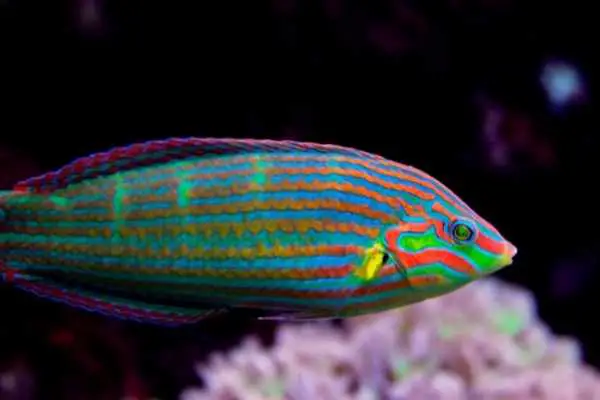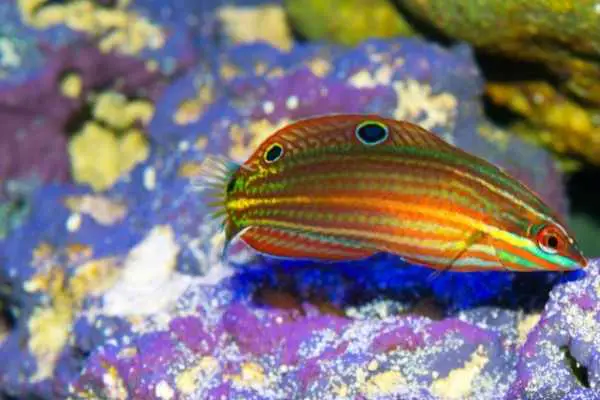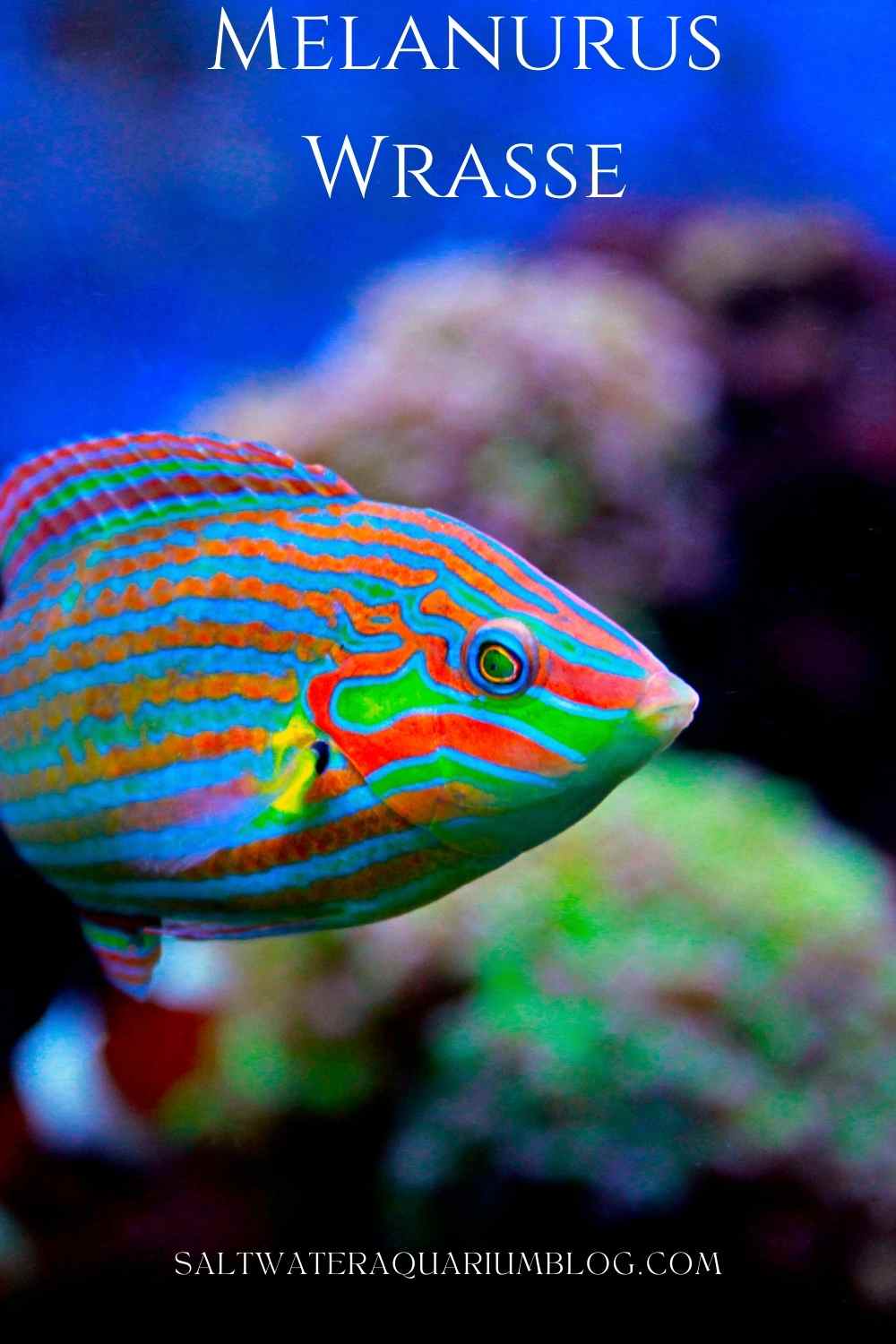Carpenter Wrasse Tail Is Light in Color
Are you looking for a great saltwater fish to add to your saltwater tank? Ask your local fish store to order you a male Melanurus wrasse – quite possibly the best-kept secret in the saltwater aquarium hobby. And if you're in any doubt, there are seven top reasons as to why you'll want to make this stunner your next aquarium addition.
Table of Contents: Melanurus Wrasse
The Melanurus wrasse comes with plenty of positives. And if you have a particular idea in mind for your reef tank, you can jump down to the link that catches your eye. But if you want to get the full effect of these gems, stick around through the entire article (you'll get the most appreciation that way – and they'll win you over in no time!).
- Common Names
- Top 7 Reasons to Keep Melanurus Wrasses
- Appearance: The Stunning Melanurus Wrasse
- Hardiness
- The Diet of the Melanurus Wrasse
- Do Melanurus Wrasses Eat Cleaner Shrimp?
- Will Melanurus Wrasses Eat Nudibranchs?
- Growth
- Melanurus Wrasses: Active Charmers
- Is the Melanurus Wrasse Aggressive?
- The Melanurus Wrasse: A Cleaner Fish?
- Reef-Safe
- Cautions with the Melanurus Wrasse
- For More Information
Common Names
If you start hunting around for your new wrasse addition, you might find yourself confronted with different names. The Melanurus wrasse also shows up as Hoeven's wrasse, tail-spot wrasse, yellow-lined wrasse, orange-tipped rainbowfish, and pinstripe wrasse. The names all attempt to capture the image of a single species: Halichoeres melanurus. However, you may see an incorrect label of Christmas wrasse, pink face wrasse, or ornate wrasse. These other fish have somewhat similar appearances. So make sure you check with the fish store as to the species you're bringing home.

Top 7 Reasons to Keep Melanurus Wrasses
If you have aspirations of beauty, activity, or ease of care, you probably have a shortlist of your favorite saltwater fish species. And if you haven't considered the Melanurus wrasse, it may be due to a lack of information. That's where this handy reference list will clue you in. Every good facet (and a few warnings) will pop out for you to peruse. And then you can decide if this delightful fish makes sense for you.
Appearance: The Stunning Melanurus Wrasse
Once you see your first Melanurus wrasse, you'll fall head over heels in love. Don't take my word for it, though. Look at these pictures (even THEY don't do this fish justice!). The adult male Melanurus wrasse starts with a typical wrasse shape and covers it in an amazing blend of turquoise blue and green colors. Then you get red, horizontal maze-like stripes from head to tail. It's similar in the palette of the six and four line wrasse species, with enough pop to make them stand out in any reef background.
Unlike some angelfish species, which start as brightly-colored juveniles and turn into drab-colored adults, Melanurus wrasses grow into their color. So if you start with a youngster, you can expect those colors to gain in intensity as your fish matures.
Adult males are considered more beautiful than females. And if you decide to keep a single wrasse, with NO other aggressive fish in the tank, you'll luck out in the deal. This species is a sequential hermaphrodite. That means they change sex depending on the social situation in the group. So all Melanurus wrasses begin life as females. And while maintaining those lovely shades, they're a little on the dull side. But without any other males around (or if they manage to become the dominant fish in a territory), the fish will change sex to male and adopt the brighter color patterns.

Hardiness
Aquarists love the Melanurus wrasse as it comes with a hardy reputation. They're almost impossible to breed in captivity (the fry don't usually survive), but it's easy to collect them from the wild. And as long as you have your new striped beauty go through the usual quarantine process, you shouldn't deal with much in the way of infection or parasites.
Part of this comes from the habit Melanurus wrasses have of burying themselves in the sand. Fish that dive into the sand – whether they're sleeping or hiding – scrape their scales between the grains. This behavior acts as a natural "barrier" against the most common parasites that like to attach to saltwater species. It's a handy pest removal process, too, as the sand flakes off the old scales the pests might try to adhere to.
And while the Melanurus wrasse usually comes into a fish store via wild collection, they don't adopt hunger strikes or other dramatic behaviors the way more delicate species might. The worst you may encounter? Once your Melanurus gets established in a tank, it can get impossible to remove them again. Aquarists ofter have to haul EVERYTHING out of an aquarium to find and catch their sneaky fish.
The Diet of the Melanurus Wrasse
One of the reasons the Melanurus wrasse does so well in an established reef aquarium is its voracious appetite. They're active fish that swim non-stop throughout the tank. And a lively personality means a high metabolism. They have short digestive tracts designed to process small amounts of food rapidly. And that means they're ALWAYS on the lookout for food – almost ANY food. Yes, that means your wrasse will happily learn to eat commercial foods.
Of course, you want to make sure you balance their diet properly. Otherwise, you won't keep those brilliant stripes looking their best. As such, you want to mix things up for these carnivores with some live or frozen proteins:
- Brine shrimp
- Mysis shrimp
- Seaweed or nori (Yes, even carnivores need a little plant life in their diets)
And to keep that digestive tract running properly, you'll need to offer food FOUR TIMES A DAY. That's higher than most of the fish in your aquarium. But an active Melanurus wrasse can start causing problems if they don't receive a proper amount of food. As such, you'll want to set a reminder to dash over and add a sprinkle of food throughout the day. (If your wrasse doesn't want to eat the seaweed, you can leave it out. They may graze on algae within the tank)

Do Melanurus Wrasses Eat Cleaner Shrimp?
As omnivores, the Melanurus wrasse doesn't mind sampling from the meaty side of the menu. And when they get hungry? They'll happily consume feather dusters, crabs, shrimp, and snails. This means they'll potentially turn on your clean-up crew, given a chance. Coral banded shrimp run the risk of consumption if you have a large male Melanurus wrasse, topping out at that 6-inch (15.2cm) length.
The key seems to be whether or not your fish is hungry. Well-fed wrasses leave the tank crustaceans in peace. It's only when their metabolism triggers a hunger response that aquarists find their fish stalking cleaner shrimp. And since the Melanurus wrasse happily probes through all crevices and cracks within live rock and corals, shrimp don't have anywhere to hide.
However, many reports online of aquarium owners say the Melanurus wrasse will not eat cleaner shrimp. (Odds are they're keeping up with the four daily feedings, though)
Will Melanurus Wrasses Eat Nudibranchs?
Now you're probably wondering about some of the other invertebrates in your tank. For instance, what if you have nudibranchs? And, as you might guess, a hungry Melanurus wrasse will eat the nudibranchs feeding on Montipora. They also target flatworms and parasitic pyramid snails. THAT probably sounds like music to your ears, but you shouldn't rush out to get a Melanurus wrasse as a pest control method. Some of those pest nudibranchs may be unpalatable and end up uneaten. More than likely, you'll find your Melanurus feeding on the nudibranchs you paid for and WANTED within the aquarium.
Growth
What's one of the worst things about starting a new saltwater aquarium? Waiting for those small, young fish you purchased to grow to their impressive adult sizes. Juvenile Melanuruss wrasses often come home from the fish store in the 1.5-2-inch (3.8-5cm) range. But they quickly grow to their full 5-inch (12.7cm) adult size. It only takes about 3 years for that little striped squirt to turn into the impressive fish you admired in all of these pictures. Compared to many slower-growing species out there, that's a record!

Melanurus Wrasses: Active Charmers
The Melanurus wrasse comes packed with personality – enough to match those vibrant colors. During the daytime hours, you the fish zipping in and out of the rockwork, hungrily looking for something to eat. And since they don't typically hassle corals, you're in the clear to stock them in your reef tank. It's only when they get hungry that you may want to worry. A starving Melanurus wrasse may start to decimate the planktonic food supply your corals need to fill that short GI tract.
But the charming behavior doesn't end when the sun goes down! When a Melanurus wrasse is ready for bed (or if it gets scared), it burrows into the sand for the night. How cool is that? The sand protects the fish from nocturnal predators that scour a reef during the overnight hours. (And, of course, it keeps those parasites away and gives the wrasse its hardy nature) Once the morning comes around, they wake up and shake off the sand to start their swimming routine again.
Oh, by the way, since this wrasse buries itself in the sand? Make sure to pick a fine grain sandy substrate.
Is the Melanurus Wrasse Aggressive?
Wrasses, in general, have an aggressive reputation. And the fact that the Melanurus wrasse will snatch up a cleaner shrimp without a second thought probably has you thinking the fish will pose problems in the tank. And since they swim almost constantly, that CAN irritate some fish within a tank, leading to chasing behaviors. But the Melanurus wrasse is actually shy, coming in on the peaceful side of the scale.
If you want to maintain calm within your aquarium, you'll want to pair them up with fish of the same size and have no chasing habits. This will keep your wrasses from needing to dive into the sand to escape harassment. You also need to avoid fish with a similar diet. For instance, dragonets and the Melanurus wrasse DON'T do well together. Not due to conflicts in personality, but because the wrasse will quickly outcompete the dragonet for the copepods available within the tank. One fish will always end up starved.
You CAN keep the Melanurus wrasse with other wrasse species – provided there's space. That even includes two males. You need room to diffuse potential tension. And you should still monitor interactions over time. As any fish ages, it tends to lose tolerance and get grumpier. That means two Melanurus wrasses that got along fine in their younger years can start to grow aggressive down the road. Always have a backup plan – just in case.

The Melanurus Wrasse: A Cleaner Fish?
Okay, so the Melanurus wrasse is ranking up checkboxes in the form categories. But how about one more in the functional category? This wrasse is a helpful fish to add to your tank courtesy of the tendency to eat parasitic pyramid snails, flatworms, bristleworms, and nudibranchs. (Well, except for the nudibranchs you DON'T want to be eaten) On their constant patrols of the aquarium, they'll hunt down all of these common pests for food. It makes them a handy part of your tank's clean-up crew.
But you don't want to rely on them 100%. Individual fish may not always have a taste for particular parasites. You could end up with a Melanurus wrasse that doesn't care for bristleworms, for instance. And then you're going to have to cope with the problem on your own.
Reef-Safe
Officially, the Melanurus wrasse comes in as MOSTLY reef-safe. I know, that's a troubling description. Aquarists prefer fish to fall into handy categories of "reef-safe" or "not reef-safe." Overall, you're in the clear. The "mostly" label comes from their habit of snatching up invertebrates. They like to eat shrimp, feather dusters, and crabs. And if you don't supply them with a proper diet, that habit will go into overdrive. But as to corals? They're in the clear. In fact, plenty of hobbyists say their Melanurus wrasses were great additions.
Of course, one aquarist mentioned his wrasse developed a habit of flipping over snails and nipping at them (without killing them). So roll the dice and watch your wrasse carefully when you add it to your reef tank.

Cautions with the Melanurus Wrasse
Watch out, the Melanurus wrasse jumps. (No, seriously!)
Unfortunately, like many wrasse species, Melanurus wrasses surf on carpets. This is because aquariums don't provide the same depth the fish get used to in the wild. When they cruise a reef and flee from a predator over a reef, they have more than a foot of water over their heads. But in a tank? That isn't the case. As such, they often sprint up and end up bolting out of the water.
Keep a tight lid on your tank, or make sure you have mesh over your open tank so your wrasse can't jump out and desiccate on your carpet. I've lost a few fish that way over the years (a real bummer).
Also, since they ARE aggressive eaters, it's best to limit yourself to ONE per tank. The Melanurus wrasse will use the entire tank as a feeding ground, picking it clean of tiny, mobile invertebrates (like copepods, amphipods, etc.). While they'll tolerate sharing space with each other, you may not be able to provide enough "ready" food for everyone. And that WILL lead to aggression problems.
And while they're not the largest fish out there, it's generally not recommended to keep this fish in anything less than 40-50 gallon (141-189L) tanks. Remember, they're active fish, and they need plenty of territory to cover throughout the day. You also need AT LEAST one inch of sand bed on the bottom for them to burrow into. Anything less, and they'll end up stressed without a proper nighttime retreat.
For More Information
STILL not convinced you to need to add a Melanurus wrasse to your tank? Well, this YouTube video ought to do the trick:
If you're looking for other awesome saltwater fish for your aquarium, how about these perfect tank mates for the Melanurus wrasse (hint, hint):
- Clownfishes
- Neon goby
- Banggai cardinalfish
Conclusion
I've been in this hobby for a long time now, and I was slow to notice the Melanurus wrasse. I knew about the stunning beauty of other wrasses, though: fairy wrasses, flasher wrasses (carpenter, McCosker's), you name it. I was also aware of the somewhat similarly colored and notoriously troublesome six line wrasse and the ubiquitous but challenging to feed bluestreak cleaner wrasses.
But somehow, the Melanurus wrasse remained a secret. Not any longer, though! And I hope you get as much enjoyment out of checking out this fish as I do.
Leave a comment and share whether you're interested in this fish or if you've already had success keeping it.


Carpenter Wrasse Tail Is Light in Color
Source: https://www.saltwateraquariumblog.com/7-reasons-to-keep-the-melanurus-wrasse/